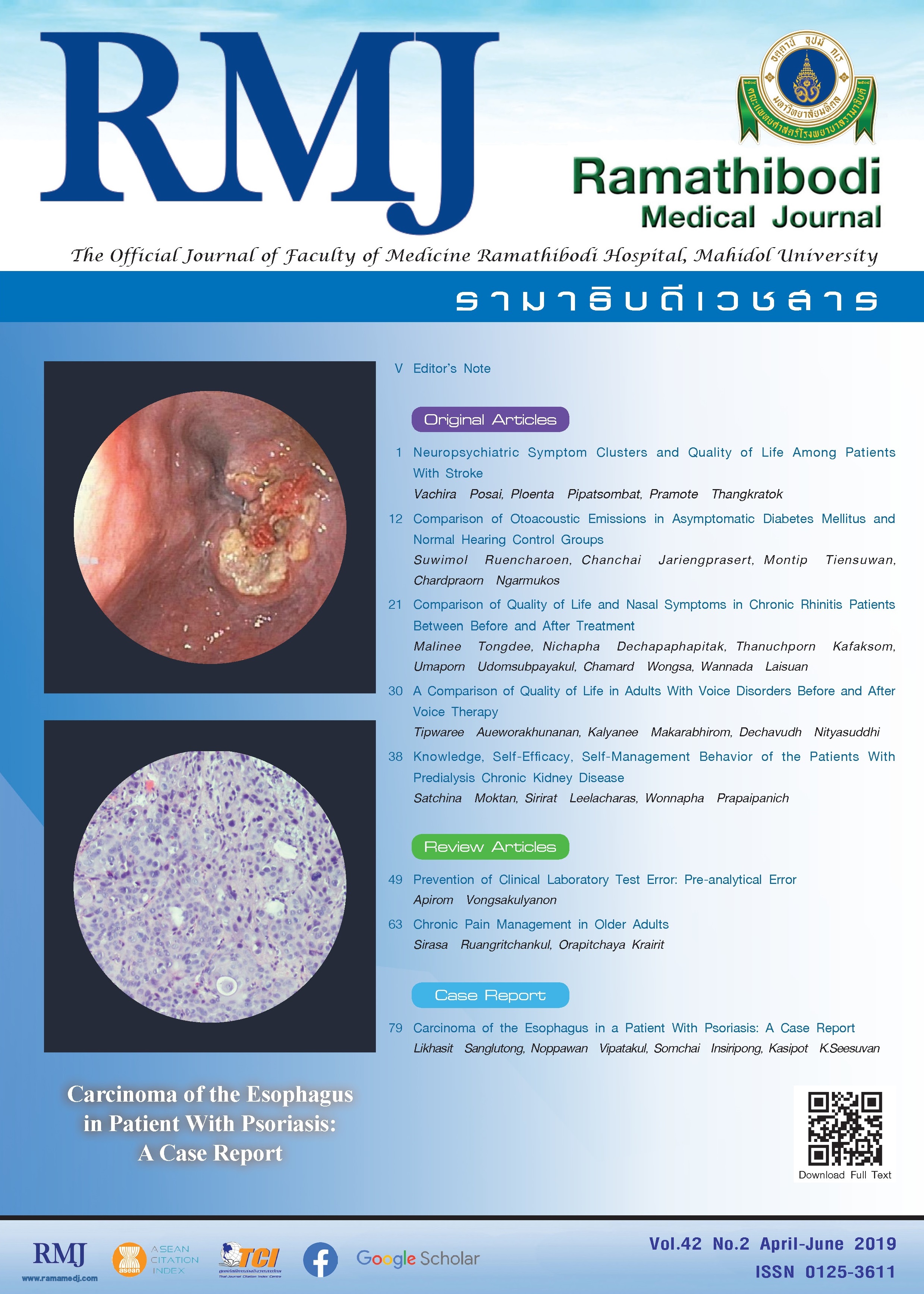Prevention of Clinical Laboratory Test Error: Pre-analytical Error
Main Article Content
Abstract
Laboratory test errors are classified into 3 categories: 1) pre-analytical error, 2) analytical error, and 3) post-analytical error. Most errors occur during pre-analytical step, usually caused by human error. The errors make laboratory result unreliable, following with the improper patient care by increasing cost, misdiagnosis, inappropriate treatment, and unexpected complication (even death). Therefore, the implementation of regulation to improve the sample handling process by accurate identification, contamination control, appropriate collection and transportation, is necessary to reduce the errors. In addition, awareness of test’s limitation and communication with laboratory service, when the result is not consistent with clinical manifestation, are also the important factors. The above measures should lead to the appropriate interpretation of laboratory result, following with the effective patient care. Apart from the laboratory test errors, the test itself could give falsely positive or falsely negative results. Therefore, the appropriate laboratory use based on indication is the vital part to minimize unnecessary consequences.
Article Details
References
James JT. A new, evidence-based estimate of patient harms associated with hospital care. J Patient Saf. 2013;9(3):122-128. doi:10.1097/PTS.0b013e3182948a69.
Makary MA, Daniel M. Medical error--the third leading cause of death in the US. BMJ. 2016;353:i2139. doi:10.1136/bmj.i2139.
Wagar EA, Yuan S. The laboratory and patient safety. Clin Lab Med. 2007;27(4):909-930, viii-ix. doi:10.1016/j.cll.2007.07.002.
Hammerling JA. A review of medical errors in laboratory diagnostics and where we are today. Lab Med. 2012;43(2):41-44.
Institute of Medicine (US) Committee on Quality of Health Care in America; Kohn LT, Corrigan JM, Donaldson MS, eds. To Err is Human: Building a Safer Health System. Washington (DC): National Academies Press (US); 2000. doi:10.17226/9728.
Dennington SR, Wilkinson DS. CQI in action in the central laboratory. Clin Lab Manage Rev. 1993;7(6):516-519.
Plebani M. The detection and prevention of errors in laboratory medicine. Ann Clin Biochem. 2010;(Pt 2):101-110. doi:10.1258/acb.2009.009222.
Bates DW, Gawande AA. Improving safety with information technology. N Engl J Med. 2003;348(25):2526-2534. doi:10.1056/NEJMsa020847.
Giavarina D, Lippi G. Blood venous sample collection: recommendations overview and a checklist to improve quality. Clin Biochem. 2017;50(10-11):568-573. doi:10.1016/j.clinbiochem.2017.02.021.
Adcock DM, Favaloro EJ, Lippi G. Critical pre-examination variables in the hemostasis laboratory and their quality indicators. Clin Biochem. 2016;49(18):1315-1320. doi:10.1016/j.clinbiochem.2016.08.022.
Cornes M, van Dongen-Lases E, Grankvist K, et al. Order of blood draw: Opinion Paper by the European Federation for Clinical Chemistry and Laboratory Medicine (EFLM) Working Group for the Preanalytical Phase (WG-PRE). Clin Chem Lab Med. 2017;55(1):27-31. doi:10.1515/cclm-2016-0426.
Wallin O, Söderberg J, Van Guelpen B, Stenlund H, Grankvist K, Brulin C. Blood sample collection and patient identification demand improvement: a questionnaire study of preanalytical practices in hospital wards and laboratories. Scand J Caring Sci. 2010;24(3):581-591. doi:10.1111/j.1471-6712.2009.00753.x.
World Health Organization. WHO guidelines on drawing blood: best practices in phlebotomy, 2010. http://www.euro.who.int/__data/assets/pdf_file/0005/268790/WHO-guidelines-on-drawing-blood-best-practices-in-phlebotomy-Eng.pdf?ua-1. Accessed February 25, 2019.
Clinical and Laboratory Standards Institute (CLSI). Procedures for the Collection of Diagnostic Blood Specimens by Venipuncture; Approved Standard. 6th ed. Wayne, PA: Clinical and Laboratory Standards Institute; 2007.
Gonsalves WI, Cornish N, Moore M, Chen A, Varman M. Effects of volume and site of blood draw on blood culture results. J Clin Microbiol. 2009;47(11):3482-3485. doi:10.1128/JCM.02107-08.
Dalton KA, Aucoin J, Meyer B. Obtaining coagulation blood samples from central venous access devices: a review of the literature. Clin J Oncol Nurs. 2015;19(4):418-423. doi:10.1188/15.CJON.19-04AP.
Koseoglu M, Hur A, Atay A, Cuhadar S. Effects of hemolysis interferences on routine biochemistry parameters. Biochem Med (Zagreb). 2011;21(1):79-85.
Mohammadhoseini E, Safavi E, Seifi S, Seifirad S, Firoozbakhsh S, Peiman S. Effect of sample storage temperature and time delay on blood gases, bicarbonate and pH in human arterial blood samples. Iran Red Crescent Med J. 2015;17(3):e13577. doi:10.5812/ircmj.13577.
Chauhan T, Suthar J, Patel RK, Patel M. Impact of time and temperature during transportation of blood samples on lymphocyte culture and chromosomal preparation. J Chem Bio Phy Sci Sec B. 2016;6(2):549-553.
Ribeiro KCB, Serabion BRL, Nolasco EL, Vanelli CP, Mesquita HL, Corrêa JOA. Urine storage under refrigeration preserves the sample in chemical, cellularity and bacteriuria analysis of ACS. J Bras Patol Med Lab. 2013;49(6):415-422. doi:10.1590/S1676-24442013000600006.
Miller JM, Binnicker MJ, Campbell S, et al. A guide to utilization of the microbiology laboratory for diagnosis of infectious diseases: 2018 update by the Infectious Diseases Society of America and the American Society for Microbiology. Clin Infect Dis. 2018;67(6):813-816. doi:10.1093/cid/ciy584.
Kim GH. Pseudohyponatremia: does it matter in current clinical practice? Electrolyte Blood Press. 2006;4(2):77-82. doi:10.5049/EBP.2006.4.2.77.
Nijsten MW, de Smet BJ, Dofferhoff AS. Pseudohyperkalemia and platelet counts. N Engl J Med. 1991;325(15):1107. doi:10.1056/NEJM199110103251515.
Sidana R, Mangala HC, Murugesh SB, Ravindra K. Prozone phenomenon in secondary syphilis. Indian J Sex Transm Dis AIDS. 2011;32(1):47-49. doi:10.4103/0253-7184.81256.
Tessier J, Downen M, Engel-Brower J, Naevem L, Sayler M, Hornig K. Pitfalls & pearls for 8 common lab tests. J Fam Pract. 2014;63(4):198-205.
Cappellini MD, Comin-Colet J, de Francisco A, et al. Iron deficiency across chronic inflammatory conditions: international expert opinion on definition, diagnosis, and management. Am J Hematol. 2017;92(10):1068-1078. doi:10.1002/ajh.24820.
Nordestgaard BG. A test in context: lipid profile, fasting versus nonfasting. J Am Coll Cardiol. 2017;70(13):1637-1646. doi:10.1016/j.jacc.2017.08.006.
Lo TS, Smego RA. Avoiding laboratory pitfalls in infectious diseases. Postgrad Med J. 2004;80(949):660-662. doi:10.1136/pgmj.2004.021170.
US Preventive Services Task Force, Grossman DC, Curry SJ, et al. Screening for prostate cancer: US Preventive Services Task Force recommendation statement. JAMA. 2018;319(18):1901-1913. doi:10.1001/jama.2018.3710.
American Society for Clinical Pathology (ASCP). Twenty-Five Things Physicians and Patients Should Question, 2018. http://www.choosingwisely.org/societies/american-society-for-clinical-pathology/. Accessed February 25, 2019.




